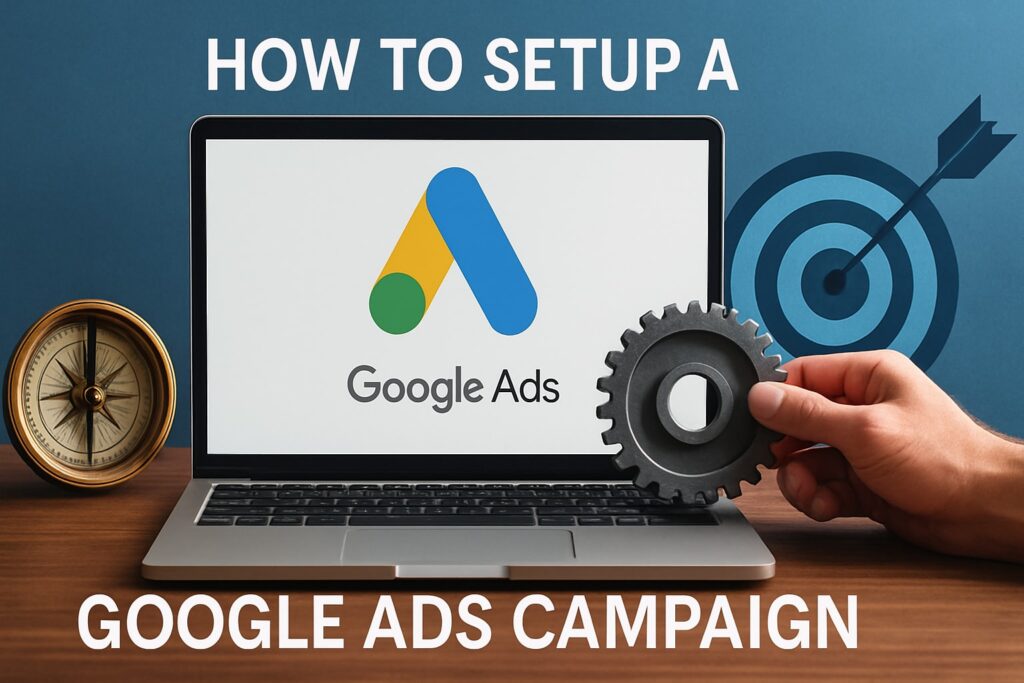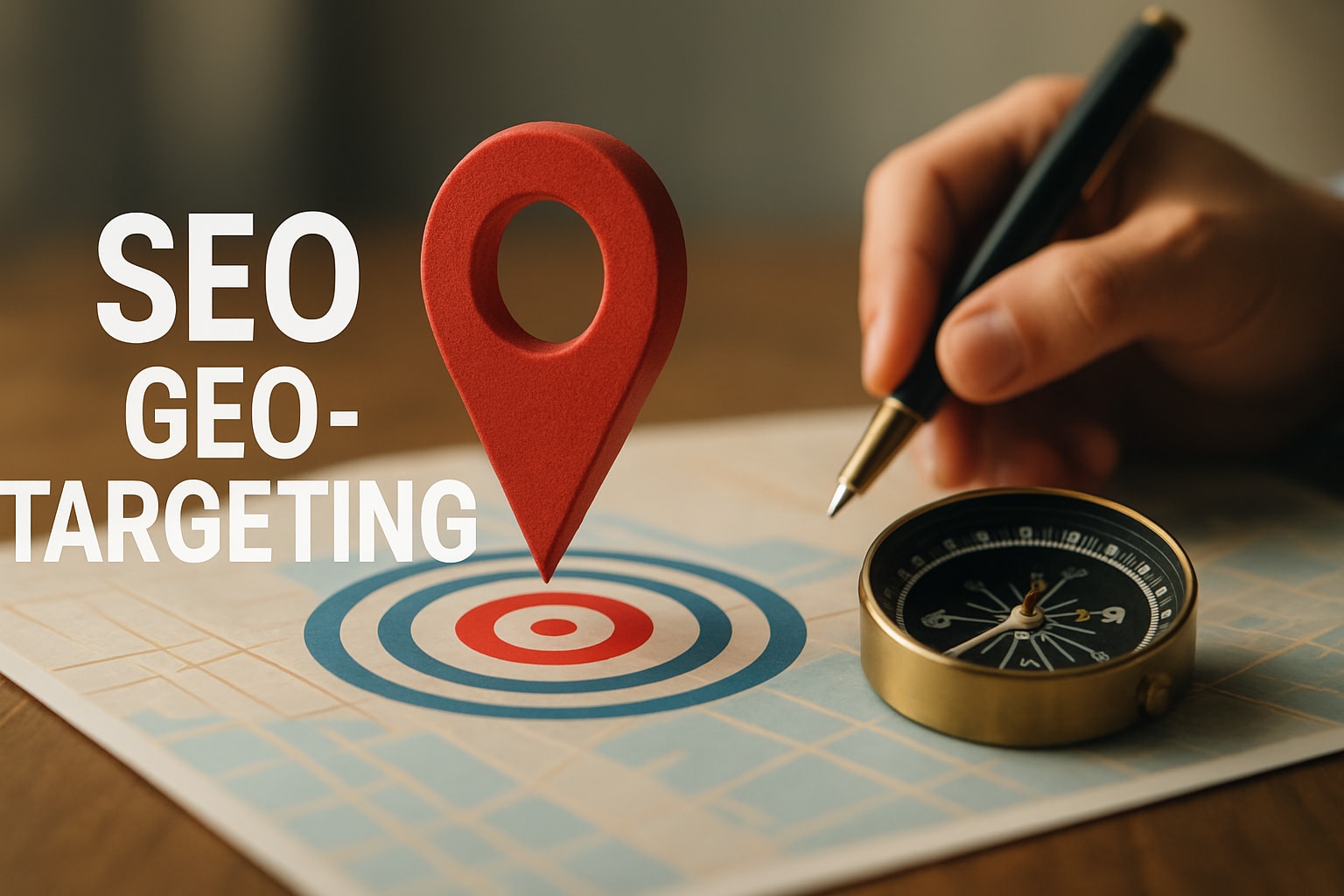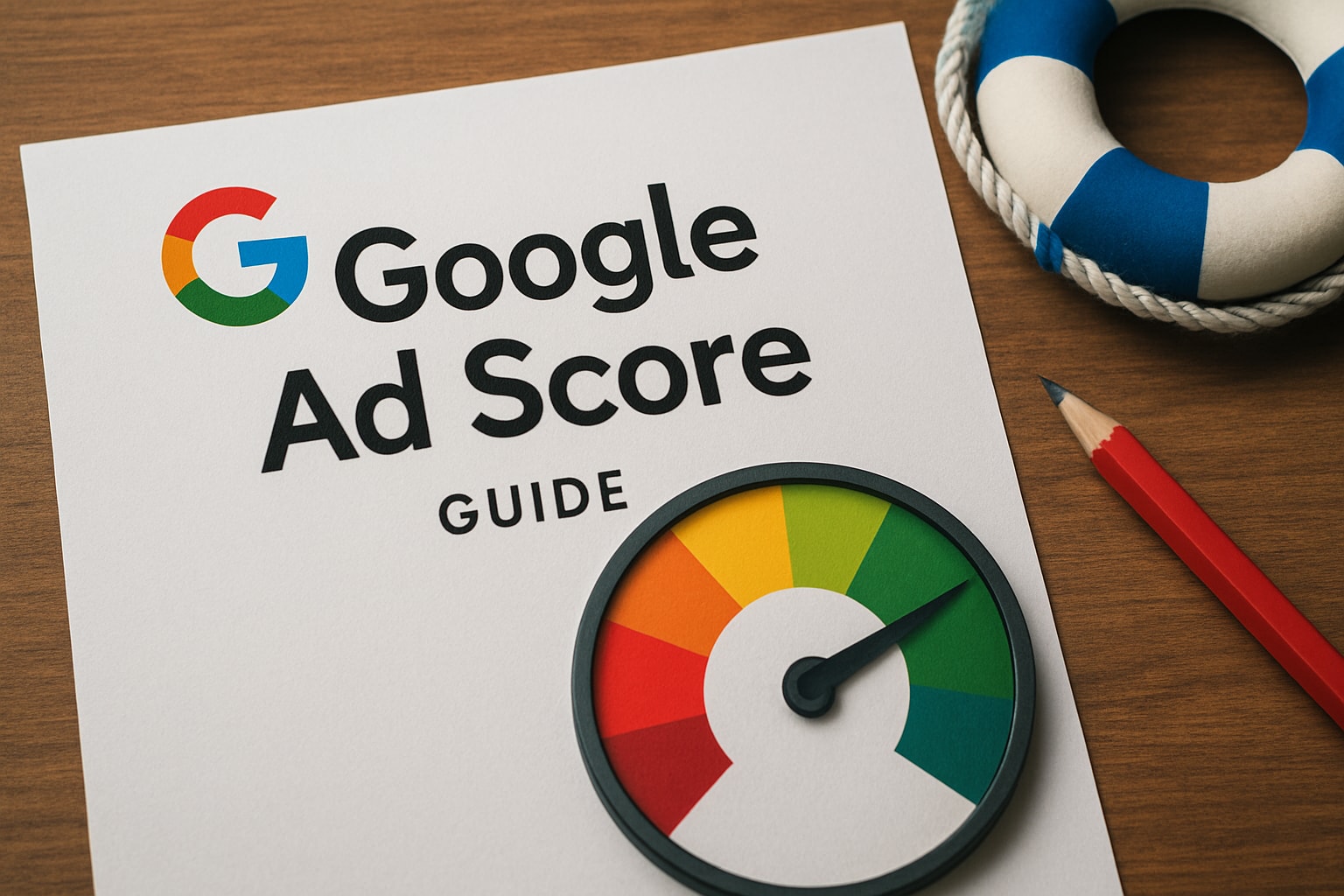Digital advertising is transforming the marine industry, with Google Ads driving a surge in bookings for yacht charters and boat rentals in 2025. If you want to stay ahead of local competitors and ensure a steady stream of customers, understanding how to setup a google ads campaign is essential for any marine business owner. This step-by-step guide reveals proven strategies for account setup, setting campaign objectives, conducting keyword research, creating effective ads, optimizing budgets, tracking results, and managing campaigns for long-term growth. Ready to boost bookings and grow your marine business? Dive into the sections below and follow each step to success.
Understanding Google Ads for the Marine Industry
Google Ads has become an essential growth engine for marine businesses in 2025. Whether you offer yacht charters, boat rentals, marina slips, or repair services, knowing how to setup a google ads campaign can mean the difference between a full season and idle docks.
Digital advertising in the marine sector is accelerating rapidly. Data from 2024 shows that over 65% of new bookings for charters and rentals now originate from paid search or local ads, not just organic search. This makes it critical for marine businesses to master how to setup a google ads campaign that outpaces the competition.
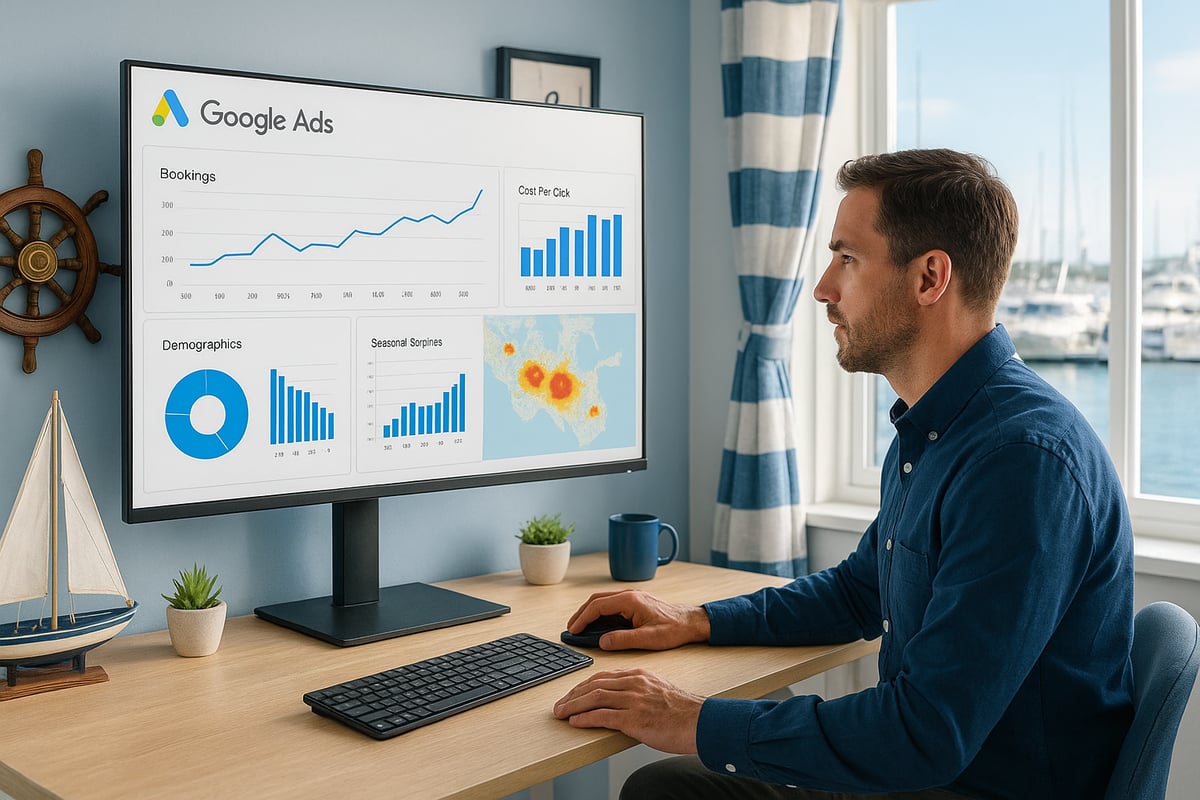
The Role of Google Ads in Marine Business Growth
Understanding how to setup a google ads campaign starts with recognizing its unique impact on the marine industry. Google Ads delivers targeted visibility to customers searching for services like "boat rental near me," "yacht charters in Miami," or "marine engine repair." These high-intent searches drive direct inquiries and bookings, especially during peak seasons.
There are three primary campaign types for marine businesses:
| Campaign Type | Best Use Case | Typical CPC* | Conversion Rate* |
|---|---|---|---|
| Search | Immediate bookings, service inquiries | $2.50–$4.00 | 7–12% |
| Display | Brand awareness, retargeting past website visitors | $1.00–$2.50 | 2–5% |
| Local | Driving foot traffic to marinas or showrooms | $2.00–$3.50 | 8–15% |
*2024 marine industry averages
Search campaigns are ideal for capturing customers ready to book, while display campaigns build awareness among boating enthusiasts. Local campaigns excel at attracting walk-ins to marinas and rental offices. For a detailed look at campaign types and best practices, see this Google Ads for marine businesses resource.
Many marine businesses face seasonal spikes in search volume. For example, "yacht charters in Miami" can surge by 300% in spring and early summer. Relying solely on organic SEO means missing out on these high-converting, time-sensitive opportunities. Knowing how to setup a google ads campaign ensures your services appear at the top when demand peaks.
The competitive landscape is fierce. Marine businesses that optimize both paid and organic strategies consistently outperform those that focus on SEO alone. Mastering how to setup a google ads campaign gives you a measurable edge.
Key Benefits and Challenges for Marine Businesses
A well-structured approach to how to setup a google ads campaign delivers measurable ROI, faster lead generation, and greater visibility than traditional marketing. With Google Ads, every click, call, and booking can be tracked, allowing you to reinvest in what works.
However, high competition for prime keywords means costs can rise quickly. Click fraud and irrelevant traffic are real risks in the marine industry, so monitoring and refining your campaign is essential.
Aligning your Google Ads strategy with clear business goals is crucial. Do you want to increase summer bookings by 30%? Generate more service inquiries? Each objective requires its own campaign structure and targeting plan.
Google’s AI and automation features in 2025 offer marine businesses new opportunities. Smart bidding, automated targeting, and responsive ad formats save time and boost performance, provided you understand how to setup a google ads campaign that leverages these tools effectively.
Compliance is also vital. Marine businesses must follow Google’s ad policies, especially for safety claims, insurance requirements, and local regulations. Staying up-to-date ensures your ads run smoothly and reach the right audience.
By investing in how to setup a google ads campaign tailored for marine, you build a foundation for predictable growth and measurable results. The next steps will dive deeper into account setup, audience targeting, and campaign optimization.
Step 1: Setting Up Your Google Ads Account
Setting up a Google Ads account is the first crucial step for any marine business aiming to capture new customers in 2025. Whether you manage a yacht charter, boat rental, or marina service, understanding how to setup a google ads campaign is essential for reaching high-intent clients and outperforming competitors.
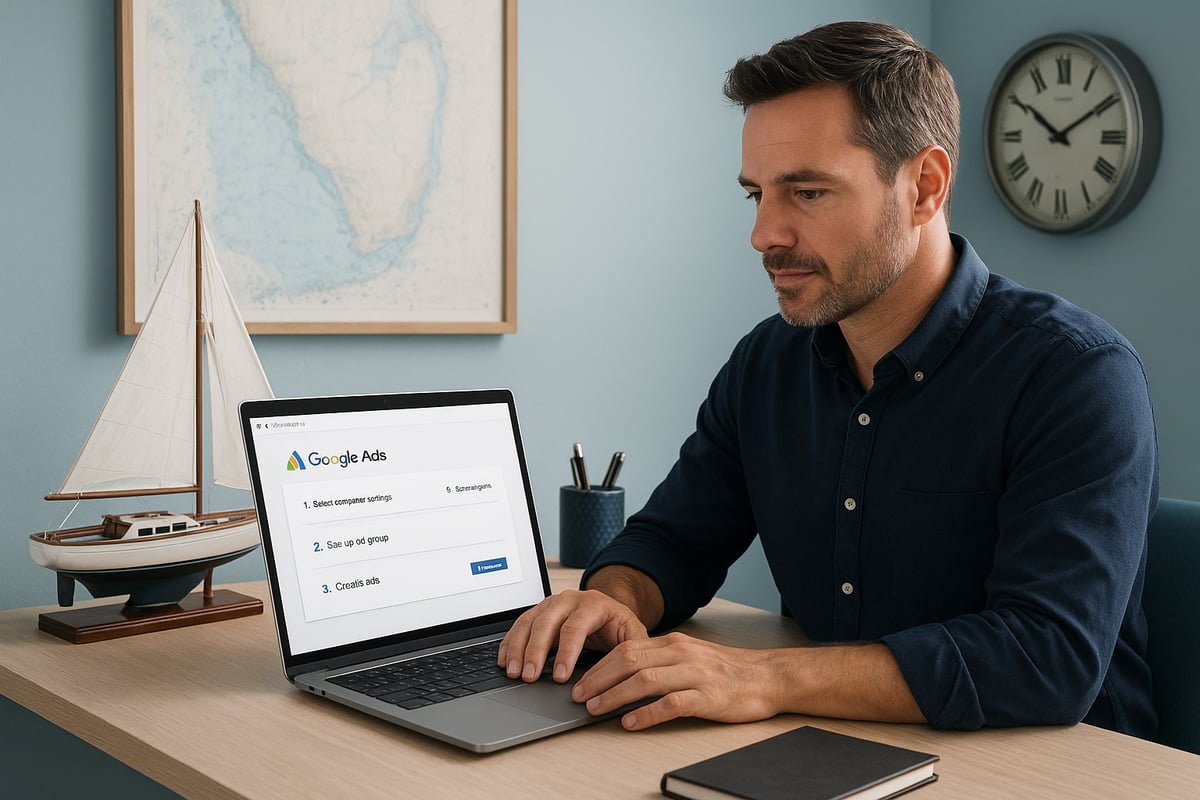
Creating and Configuring Your Account
Begin your journey by visiting the Google Ads homepage. Select “Start Now,” then sign in using your business email. For marine businesses, accuracy in business details is vital, so enter your official company name, website, and location.
Next, verify your account through the email sent by Google. This step keeps your account secure and ensures you receive important notifications. For multi-location marine operations, consider setting up a Manager Account. This structure allows you to oversee separate locations—like marinas in different cities—under one umbrella, streamlining how to setup a google ads campaign for each service area.
Once your account is verified, configure billing details. Choose your preferred payment method, set your billing country, and verify tax information. Assign user access carefully, granting permissions only to trusted team members or your digital marketing agency.
Linking Google Analytics is a must for marine businesses. This integration lets you track website traffic, booking actions, and campaign results. If you offer multiple services—such as charters, repairs, and sales—create separate campaigns or sub-accounts for each. This organization gives you better control over budgets and reporting.
For additional guidance on each setup step, explore resources like the Google Ads campaign setup guide 2025, which outlines the latest best practices.
Navigating the Google Ads Dashboard
After setup, familiarize yourself with the Google Ads dashboard. This is your command center for how to setup a google ads campaign and monitor performance. The Overview tab gives you a snapshot of clicks, impressions, and conversions, all vital for marine business growth.
The Campaigns tab allows you to manage and adjust campaigns for different services or locations. Here, you can pause ads for boat rentals during the off-season or boost yacht charter ads before a major regatta.
Use the Reporting tab to generate custom reports. Track metrics such as cost per click, booking conversions, and seasonal trends. For example, during peak boating season, monitor your live campaign data to ensure your ads appear at the right times and locations.
Organize your dashboard by service, vessel type, or location to simplify management. This structure makes it easier to identify which campaigns drive the most bookings and where adjustments are needed.
Mastering the dashboard is essential for anyone learning how to setup a google ads campaign in the marine sector. By understanding these tools, you can react quickly to changing demand and maximize your return on investment.
Step 2: Defining Campaign Objectives and Target Audience
Setting clear objectives and understanding your ideal customers are foundational steps in how to setup a google ads campaign for any marine business. This stage ensures your ad spend is driving real business results, not just clicks. By aligning your campaign type and audience targeting with your business goals, you lay the groundwork for measurable growth.

Selecting the Right Campaign Type for Marine Services
Choosing the right campaign type is a pivotal part of how to setup a google ads campaign tailored to your marine offerings. Each campaign type serves unique objectives and reaches customers at different stages of their buying journey.
Search campaigns help you appear when someone types high-intent queries like "boat rental near me" or "yacht charters Miami." These are ideal for driving direct bookings and inquiries.
Display campaigns increase your visibility by placing banner ads on relevant websites. Marine businesses can use these to build awareness for new services or highlight seasonal promotions.
Local campaigns are perfect for marinas and service providers aiming to boost foot traffic. These ads automatically optimize across Search, Maps, and Display to reach users near your physical location.
Performance Max campaigns leverage Google’s AI to reach customers across all Google channels. For 2025, they can be a powerful option for marine businesses seeking comprehensive exposure and automated optimization.
| Campaign Type | Best Use Case | Example in Marine Industry |
|---|---|---|
| Search | Direct bookings/leads | Yacht charter inquiries |
| Display | Brand awareness/promos | Boat show promotions |
| Local | Increase visits/footfall | Marina slip rentals |
| Performance Max | Full-funnel, automation | Multi-service marine businesses |
Selecting the right type depends on your business goals, location, and customer journey. Understanding these options is crucial when planning how to setup a google ads campaign that delivers results.
Setting SMART Goals for Your Campaign
To maximize your investment, it’s essential to set SMART goals before launching your marine Google Ads campaign. SMART stands for Specific, Measurable, Achievable, Relevant, and Time-bound. This framework ensures you have a clear target and a way to measure success.
Here’s how to set a SMART goal for a marine business:
- Specific: Define what you want to achieve (e.g., increase yacht charter bookings).
- Measurable: Set a numeric goal (e.g., boost bookings by 30%).
- Achievable: Ensure the target is realistic based on past data.
- Relevant: Align the goal with your business priorities.
- Time-bound: Set a deadline (e.g., peak summer season).
Case Study Example: A Miami-based yacht charter agency set a goal to grow summer bookings by 30% using Search and Performance Max campaigns. By tracking conversions and optimizing bids, they exceeded their target within three months.
For even more actionable strategies, explore this Lead generation for marine businesses resource. It complements your understanding of how to setup a google ads campaign with proven tactics for attracting and converting leads.
Defining SMART goals not only guides your campaign setup but also ensures you can prove ROI, adjust strategies, and scale what works.
Audience Targeting Strategies for Marine Businesses
Pinpointing your target audience is the final, crucial step in how to setup a google ads campaign that delivers quality leads for marine services. Google Ads offers powerful targeting tools to reach the right prospects.
Demographic targeting lets you refine your ads by age, income, and interests—vital for luxury yachting or family boat rentals.
Geo-targeting allows you to focus your budget on waterfront communities, popular marinas, and high-traffic tourist zones. This ensures your ads appear where your ideal customers are searching and booking.
Custom intent audiences help you reach users actively researching marine services, while remarketing targets previous website visitors for repeat bookings and increased lifetime value.
Many successful marine businesses also analyze competitor campaigns to uncover gaps in targeting and messaging. By refining your audience settings, you ensure every dollar in your campaign is working toward your goals.
A strategic approach to audience targeting will set your marine business apart, making your efforts in how to setup a google ads campaign truly pay off.
Step 3: Keyword Research and Ad Group Structuring
Keyword research is the foundation of how to setup a google ads campaign that delivers bookings and leads for marine businesses. The right keywords put your ads in front of people who are actively searching for boat rentals, yacht charters, or marine repairs. Effective research and precise ad group structuring can help you outshine competitors and maximize your ad spend.
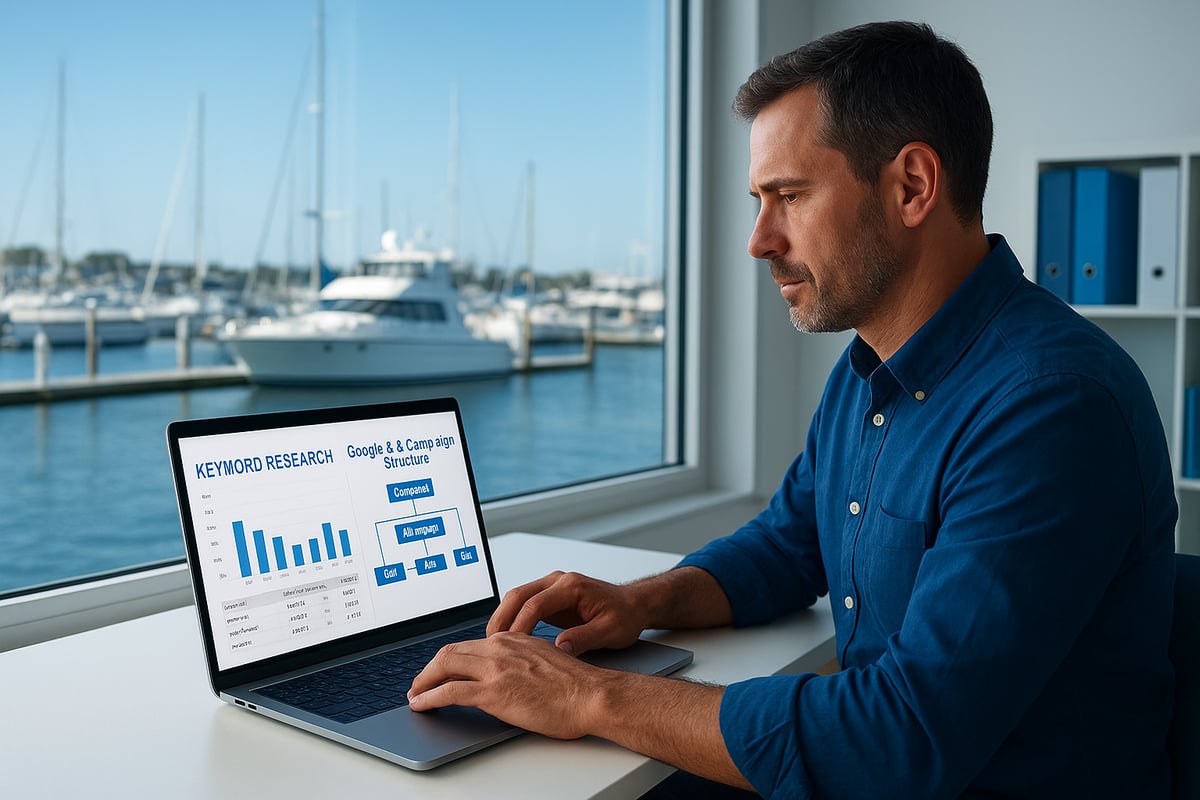
Conducting Effective Keyword Research for Marine Businesses
When considering how to setup a google ads campaign for your marine business, start with comprehensive keyword research. Use tools like Google Keyword Planner, SEMrush, or Ahrefs to discover search terms customers use, such as “boat rental Miami,” “yacht charter Fort Lauderdale,” or “marine engine repair near me.”
Focus on high-intent keywords that signal commercial interest. For example, someone searching “book yacht charter Miami” is more likely to convert than a user looking up “yacht history.” Analyze search volume and competition data, aiming for keywords with solid traffic but manageable competition.
To refine your list, add negative keywords. Exclude terms like “free boats” or “DIY marine repairs” to avoid wasting budget on irrelevant clicks. This step is crucial in how to setup a google ads campaign that targets only valuable prospects.
Marine businesses often see seasonal spikes in searches. Terms such as “sailing lessons summer 2025” or “boat rental Fourth of July” can drive substantial traffic during peak months. Adjust your keyword strategy to capitalize on these trends.
For a detailed walkthrough on research methods and structuring your keyword strategy, review these Google Ads keyword research techniques. This resource offers actionable steps tailored for service-based campaigns.
Combine broad match, phrase match, and exact match keywords to balance reach and precision. Always align your keywords with your marine services and local areas for best results.
Structuring Ad Groups for Maximum Relevance
Once your keyword list is ready, the next phase of how to setup a google ads campaign is organizing your ad groups. Structure each ad group around a single service, vessel type, or geographic location. For example, dedicate separate ad groups to “yacht charters Miami,” “fishing boat rentals Key West,” and “marine repairs Tampa.”
Grouping related keywords tightly ensures your ads match searcher intent. This alignment directly impacts your Quality Score, which can lower costs and improve ad visibility.
Consider this comparison:
| Ad Group Structure | Example Keywords | Benefit |
|---|---|---|
| By Service | “yacht charter,” “sailing lessons” | Specific ad copy, higher relevance |
| By Vessel Type | “pontoon rental,” “sport fishing” | Tailored messaging, better CTR |
| By Location | “boat rental Miami,” “marina Naples” | Local targeting, improved conversions |
Well-structured ad groups allow you to create highly relevant ads and landing pages. For instance, an ad group for “fishing boat rentals” should only contain keywords and ads focused on that service, not on “luxury yacht charters.”
Data from the marine industry shows that campaigns with tightly themed ad groups see up to 30% higher click-through and conversion rates. This approach streamlines reporting and makes it easier to optimize bids and budgets for each segment.
As you refine how to setup a google ads campaign, regularly review your ad group performance. Identify underperforming groups and adjust keywords, ads, or targeting to maximize results. This ongoing process ensures your marine business stays ahead in a competitive digital marketplace.
Step 4: Crafting Compelling Ads and Extensions
In the marine industry, the difference between an average and a high-performing Google Ads campaign lies in the details of your ad copy and the strategic use of ad extensions. Knowing how to setup a google ads campaign that speaks directly to boaters, yacht enthusiasts, and marine service seekers is essential for standing out in a competitive digital seascape.
Writing High-Converting Ad Copy for Marine Services
Effective ad copy is the anchor of how to setup a google ads campaign that delivers real results for marine businesses. Start with attention-grabbing headlines that clearly state your offering, such as "Luxury Yacht Charters in Miami" or "Safe, Certified Boat Rentals." Your descriptions should highlight unique selling points like safety certifications, luxury amenities, or exclusive seasonal offers that set your marine business apart.
Consider emotional triggers that connect with your audience’s aspirations. Phrases such as "Experience the thrill of the open water" or "Create unforgettable memories with family and friends" can drive engagement and clicks. Always ensure your copy complies with Google Ads policies by avoiding prohibited claims and focusing on verifiable benefits.
To further refine your approach, analyze successful campaigns in your niche. For example, yacht charter operators often emphasize privacy, premium service, and flexible booking terms in their ads. For more inspiration on crafting marine-specific messaging, review proven Yacht charter SEO strategies that can complement your ad creation process.
Here are some key best practices for ad copy in marine campaigns:
- Use keywords naturally in headlines and descriptions for relevance.
- Feature trust signals like "Coast Guard Certified" or "5-Star Customer Reviews."
- Offer clear calls to action, such as "Book Your Charter Today" or "Reserve a Slip Now."
- Adapt copy seasonally to match peak demand periods.
The foundation of how to setup a google ads campaign for marine services is ensuring every word resonates with your target audience and drives measurable action.
Leveraging Ad Extensions for More Visibility
Ad extensions enhance how to setup a google ads campaign by providing additional information and increasing your ad’s visibility on the search results page. These features can significantly improve click-through rates and generate more qualified leads for your marine business.
Common ad extensions for marine campaigns include:
- Sitelink Extensions: Highlight additional services like "Boat Repair," "Group Charters," or "Marina Amenities."
- Call Extensions: Enable potential clients to connect instantly for charter inquiries or slip reservations.
- Location Extensions: Show your marina or rental office on Google Maps, driving local traffic.
- Structured Snippets: Feature categories such as "Vessel Types: Yachts, Pontoons, Sailboats."
A/B testing different combinations of ad extensions is crucial for optimizing performance. For instance, adding call extensions during peak boating season can lead to a 15-25% increase in direct inquiries. Use the reporting features in your dashboard to compare metrics like click-through rate and cost per conversion for each extension.
Below is a quick comparison of popular ad extensions and their impact:
| Extension Type | Best For | Typical Uplift in CTR |
|---|---|---|
| Sitelink | Promoting multiple services | 10-20% |
| Call | Direct bookings/inquiries | 15-25% |
| Location | Driving marina visits | 15-30% |
| Structured Snippet | Showcasing offerings | 8-15% |
By mastering how to setup a google ads campaign with well-crafted ads and thoughtfully selected extensions, marine businesses can maximize visibility, attract high-value customers, and achieve predictable growth.
Step 5: Setting Budgets, Bidding, and Conversion Tracking
A successful marine Google Ads campaign hinges on three pillars: strategic budgeting, smart bidding, and precise conversion tracking. Understanding how to setup a google ads campaign with these elements ensures you reach the right customers, maximize return on investment, and gain actionable insights for ongoing growth.
Budgeting Strategies for Marine Businesses
Setting an effective budget is essential when learning how to setup a google ads campaign for the marine sector. Begin by estimating your daily or monthly ad spend based on seasonal demand. For example, allocate more during peak boating months when search volume and competition increase.
Typical marine industry cost-per-click (CPC) benchmarks range from $1.50 to $4.50. High-value keywords like “yacht charter Miami” may cost more, while generic terms remain affordable. Consider customer lifetime value and average booking revenue to determine a sustainable starting budget.
Here is a sample budget allocation table:
| Service | Suggested % of Budget | Example Monthly Spend (USD) |
|---|---|---|
| Yacht Charters | 40% | $1,200 |
| Boat Rentals | 30% | $900 |
| Repairs/Services | 20% | $600 |
| Accessories Sales | 10% | $300 |
Adjust your spend to prioritize services with the highest margins or seasonal demand. Always revisit your budget regularly as you discover what works best for your business and how to setup a google ads campaign that adapts to changing trends.
Choosing the Right Bidding Strategy in 2025
Selecting the optimal bidding approach is vital in how to setup a google ads campaign that delivers results. In 2025, Google offers a range of automated bidding tools designed to maximize conversions and efficiency.
Smart Bidding uses machine learning to optimize for conversions or conversion value, adjusting bids in real time. Target CPA (Cost Per Acquisition) and Maximize Conversions are popular options for marine businesses aiming for predictable costs and steady bookings. Manual bidding gives you more control but requires ongoing adjustments.
Compare the main bidding strategies:
| Bidding Strategy | Best For | Automation Level |
|---|---|---|
| Smart Bidding | Bookings, ROI, efficiency | High |
| Target CPA | Stable cost per lead | Medium |
| Maximize Conversions | Volume-focused campaigns | High |
| Manual CPC | Niche or test campaigns | Low |
For advanced insights on AI and automation in Google Ads, see the Google Ads AI and automation features 2025 guide. Marine advertisers often benefit from automated bidding, especially during high-traffic seasons, but always monitor results and test different tactics to see what best fits your goals in how to setup a google ads campaign.
Setting Up Conversion Tracking for Bookings and Leads
Accurate conversion tracking is a cornerstone of how to setup a google ads campaign for marine businesses. Begin by integrating Google Ads with Google Analytics. This enables you to track key actions such as phone calls, online bookings, and contact form submissions.
Set up conversion goals for each service. For instance, track completed bookings for yacht charters, or measure how many visitors schedule maintenance appointments. Use phone call tracking to capture leads from mobile searchers.
With robust tracking in place, analyze which keywords, ads, and landing pages drive the most valuable actions. This data empowers you to refine targeting, adjust budgets, and improve ROI. Remember, continual optimization based on conversion insights is what separates top-performing marine Google Ads campaigns from the rest.
Step 6: Monitoring, Optimizing, and Scaling Your Campaigns
Effectively managing your marine business’s paid advertising means understanding how to setup a google ads campaign for long-term growth. Once your campaigns are live, the real work begins—continually monitoring data, optimizing tactics, and scaling what works. In this step, you’ll learn how to turn every dollar spent into measurable results.
Analyzing Campaign Performance Metrics
To master how to setup a google ads campaign for marine services, you must regularly review your campaign metrics. Key indicators include click-through rate (CTR), conversion rate, cost per conversion, and impression share. Each metric tells a story about how your ads resonate with boaters, yacht seekers, or marine service clients.
| Metric | Marine Industry Benchmark | Why It Matters |
|---|---|---|
| CTR | 4.5%–6% | Gauges ad engagement |
| Conversion Rate | 5%–10% | Measures booking efficiency |
| Cost per Conversion | $25–$80 (varies by service) | Tracks ROI on each lead |
| Impression Share | 60%+ | Reveals visibility vs. rivals |
During peak boating season, monitor these metrics daily. For example, if your yacht charter campaign's CTR drops below the benchmark, review your ad copy and keywords. Use the Overview and Reporting tabs in Google Ads to pinpoint underperforming keywords or ads. Before major marine events, adjust your campaigns to maximize impression share and conversions.
Ongoing Optimization Tactics for Marine Businesses
Continuous improvement is at the heart of how to setup a google ads campaign that drives bookings. Start by A/B testing ad headlines and descriptions—small tweaks can double your click rate. Adjust bids to favor high-performing keywords, especially during weekends or holidays when demand surges.
Key optimization tactics include:
- Adding negative keywords to block irrelevant traffic, reducing wasted spend.
- Refining geo-targeting to focus on marinas, waterfronts, or luxury neighborhoods.
- Automating bid adjustments using Google’s AI tools, which have become more precise for the marine sector in 2025.
- Reviewing search terms reports weekly to spot new opportunities or filter out low-value clicks.
A recent case study showed that a marina doubled its summer bookings by continually refining ads, updating seasonal offers, and leveraging structured ad groups. For a holistic approach, pair your paid strategy with an SEO checklist for marine industry to boost both organic and paid visibility.
Scaling Successful Campaigns Across Services and Locations
Knowing how to setup a google ads campaign is just the beginning—scaling is where you achieve transformative growth. Identify your top-performing campaigns by location or service, then replicate their structure for new marinas, charter routes, or repair services.
To scale efficiently:
- Copy high-ROI campaigns and tailor ads for new destinations or vessel types.
- Reallocate budget to campaigns with the highest conversion rates.
- Expand geo-targeting to include nearby tourist hotspots or seasonal markets.
- Use insights from conversion tracking to refine offers and landing pages.
For multi-location marine businesses, synchronize your paid ads with local marketing efforts. Consider referencing the Local SEO for marine businesses guide to align your Google Ads targeting with organic search strategies in every port you serve.
By following these strategies, you’ll ensure your campaigns not only perform well today but are primed for ongoing growth and adaptability in the fast-evolving marine industry.
Now that you know how to set up a Google Ads campaign tailored for the marine industry, imagine how much faster you could reach your goals with expert support. At Aquatic SEO, we combine real-world marine experience with advanced digital marketing strategies, so you’re never left guessing about your next booking. If you’re ready to turn insights into action and keep your calendar full, let’s talk about how we can help you dominate search, boost your bookings, and maximize your ROI—all year round.
Schedule a Free Strategy Call

